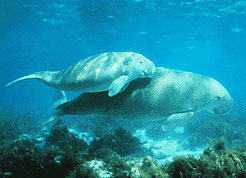Dugong dugon
The dugong or dugón (Dugong dugon) is the smallest current sirenian, the only representative of its genus and the only surviving member of the family Dugongidae, which also included the extinct Steller's sea cow.
Features
It is smaller in size (3 meters in length and 200 kilograms in weight), it differs from manatees in the bilobed shape of its caudal fin, similar to that of a cetacean, the presence of rudimentary remains of the hind limbs in the skeleton (not visible from the outside), its most primitive pelvis and its peculiar dentition. Adults lack molars and use horny plates to grind food; In addition, males have a pair of protruding incisors similar to those of elephants.
Distribution
It is distributed along coastal areas of the Indian and Pacific oceans. Coastal areas of eastern Africa, from the Sinai to southern Mozambique, waters of Madagascar, several islands in the Indian Ocean, India, Sri Lanka, the Indochina Peninsula, Indonesia, the Philippines, New Guinea and northern Australia. To the east they reach the Solomon Islands and French Polynesia, and to the north they reach the islands of Hainan (China), Taiwan and the Ryukyu Islands of Japan.
Behavior
It is a peaceful herbivore that feeds only on algae in coastal areas, where it usually grazes at night. Its swimming ability is not amazing, as it usually spends 15 minutes between one dive and another and rarely dives deeper than 10 meters.
Like manatees, they do not enter waters with temperatures below 20 °C, but unlike manatees, they do not enter fresh water. Dugongs live solitary, in pairs or in small family groups, although in some exceptional cases the presence of up to 100 individuals has been documented feeding in the same area.
Playback

They reach sexual maturity between 9 and 15 years of age, and the maximum life expectancy of individuals is 50 years, sometimes up to 70 years in exceptional cases.
Mating occurs at any time of the year, although most births occur between July and September. Females give birth to their first offspring from the age of ten, with subsequent births occurring at intervals of 3 to 5 years. Females nurse their offspring for a maximum of a year and a half (although they also eat algae during this period).) in a very 'human' way: mothers, with their heads and shoulders out of the water, usually hold their babies while they suck from the two nipples between their fins. It is not surprising, then, that dugongs are considered the animals that gave rise to the myth of mermaids. The word dugong itself derives from the Malay duyong, which means precisely that, mermaid.
Threats
Its meat and fat are highly valued in the Indian Ocean markets, which is why it has been ruthlessly persecuted in many areas. To this we must add accidents with the propellers of motor boats and cases in which they become entangled in trawl nets. Because of this, its population has suffered in many areas and has only improved in waters near Australia due to more effective government protection. Apart from man, dugongs have sharks and killer whales as their only predators.
Declaration of Extinction in China
Researchers from the Zoological Society of London (ZSL) and the Chinese Academy of Sciences reported on August 24, 2022 that the dugong (Dugong dugon) is "functionally extinct" in China. According to research was published in the journal of the Royal Society of Open Science, it is the first functional extinction of a large mammal in the waters off the coast of China. There are no documented records of sightings of the species after 2008, nor verified field observations after 2000, therefore the researchers concluded that dugongs have experienced a rapid population collapse over the past decades and are now functionally extinct in China..
Contenido relacionado
Rhinocerotidae
Bovidae
Pan paniscus
Gekkonidae
Carcharhiniformes